Australian Nursing Workforce Assessment for Health Workforce Planning
VerifiedAdded on 2023/06/13
|12
|2286
|422
Report
AI Summary
This report provides a detailed assessment of the Australian Nursing Workforce, focusing on the challenges of retaining and hiring nurses amidst increasing healthcare service demands. It includes updated tables of nursing workforce data from 2008 to 2015 and analyzes workforce characteristics, supply, and future status. The report addresses the impact of an aging population and changing health trends on the nursing workforce, highlighting the shortage of skilled nurses and the need for improved workforce planning. It also examines geographical distribution and the role of technology in healthcare services, concluding that organizations need to focus on both workforce planning and technological advancements to meet growing healthcare demands. Desklib provides access to similar solved assignments and past papers for students.
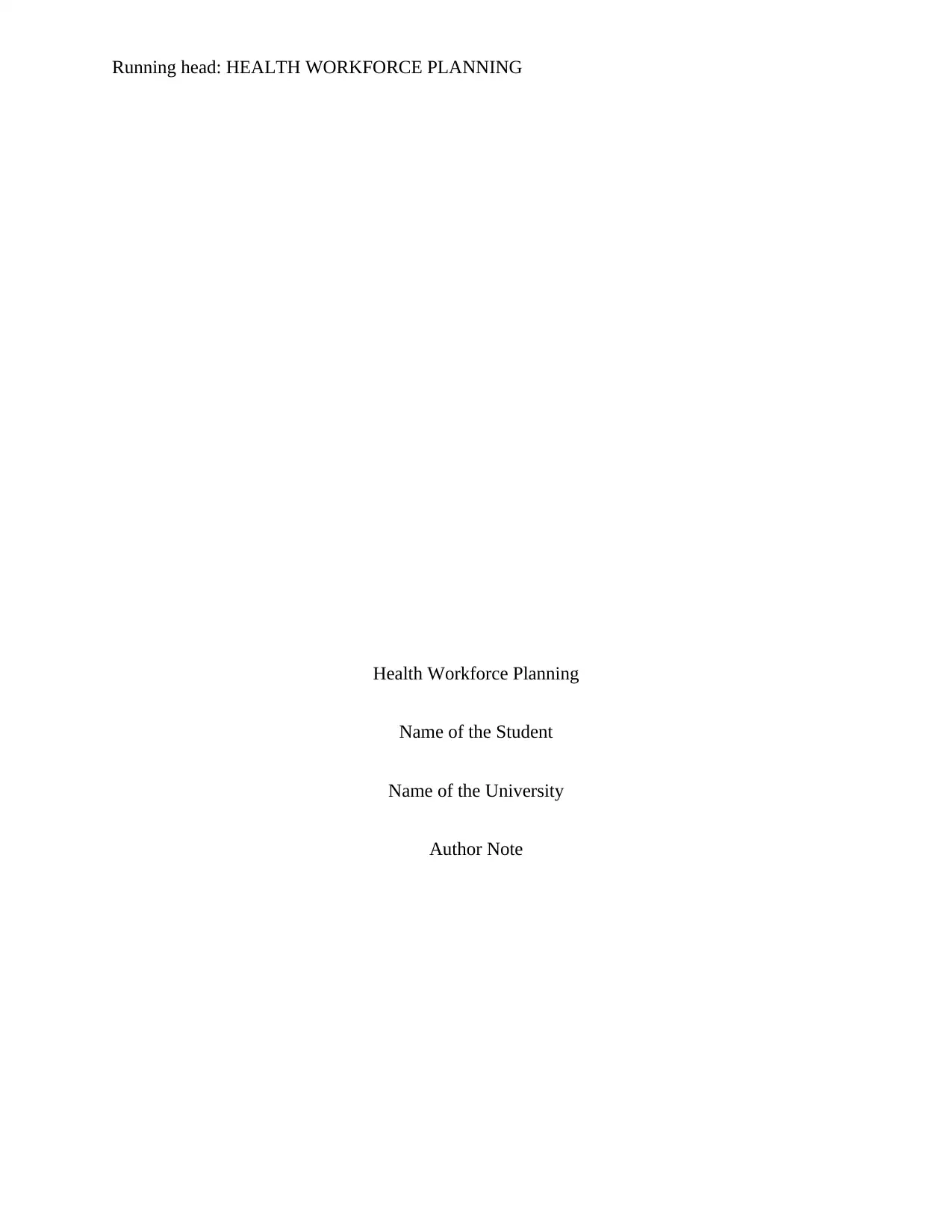
Running head: HEALTH WORKFORCE PLANNING
Health Workforce Planning
Name of the Student
Name of the University
Author Note
Health Workforce Planning
Name of the Student
Name of the University
Author Note
Paraphrase This Document
Need a fresh take? Get an instant paraphrase of this document with our AI Paraphraser
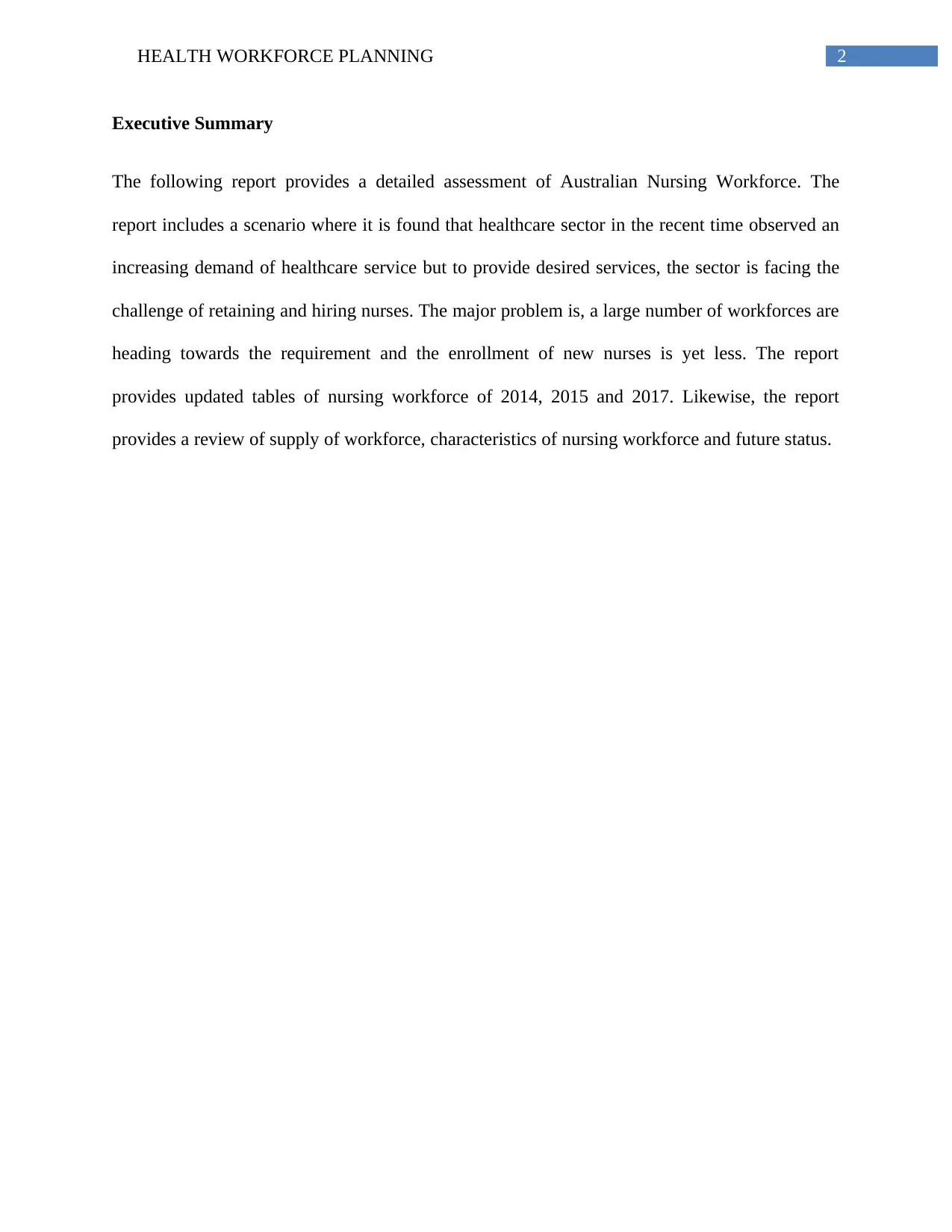
2HEALTH WORKFORCE PLANNING
Executive Summary
The following report provides a detailed assessment of Australian Nursing Workforce. The
report includes a scenario where it is found that healthcare sector in the recent time observed an
increasing demand of healthcare service but to provide desired services, the sector is facing the
challenge of retaining and hiring nurses. The major problem is, a large number of workforces are
heading towards the requirement and the enrollment of new nurses is yet less. The report
provides updated tables of nursing workforce of 2014, 2015 and 2017. Likewise, the report
provides a review of supply of workforce, characteristics of nursing workforce and future status.
Executive Summary
The following report provides a detailed assessment of Australian Nursing Workforce. The
report includes a scenario where it is found that healthcare sector in the recent time observed an
increasing demand of healthcare service but to provide desired services, the sector is facing the
challenge of retaining and hiring nurses. The major problem is, a large number of workforces are
heading towards the requirement and the enrollment of new nurses is yet less. The report
provides updated tables of nursing workforce of 2014, 2015 and 2017. Likewise, the report
provides a review of supply of workforce, characteristics of nursing workforce and future status.
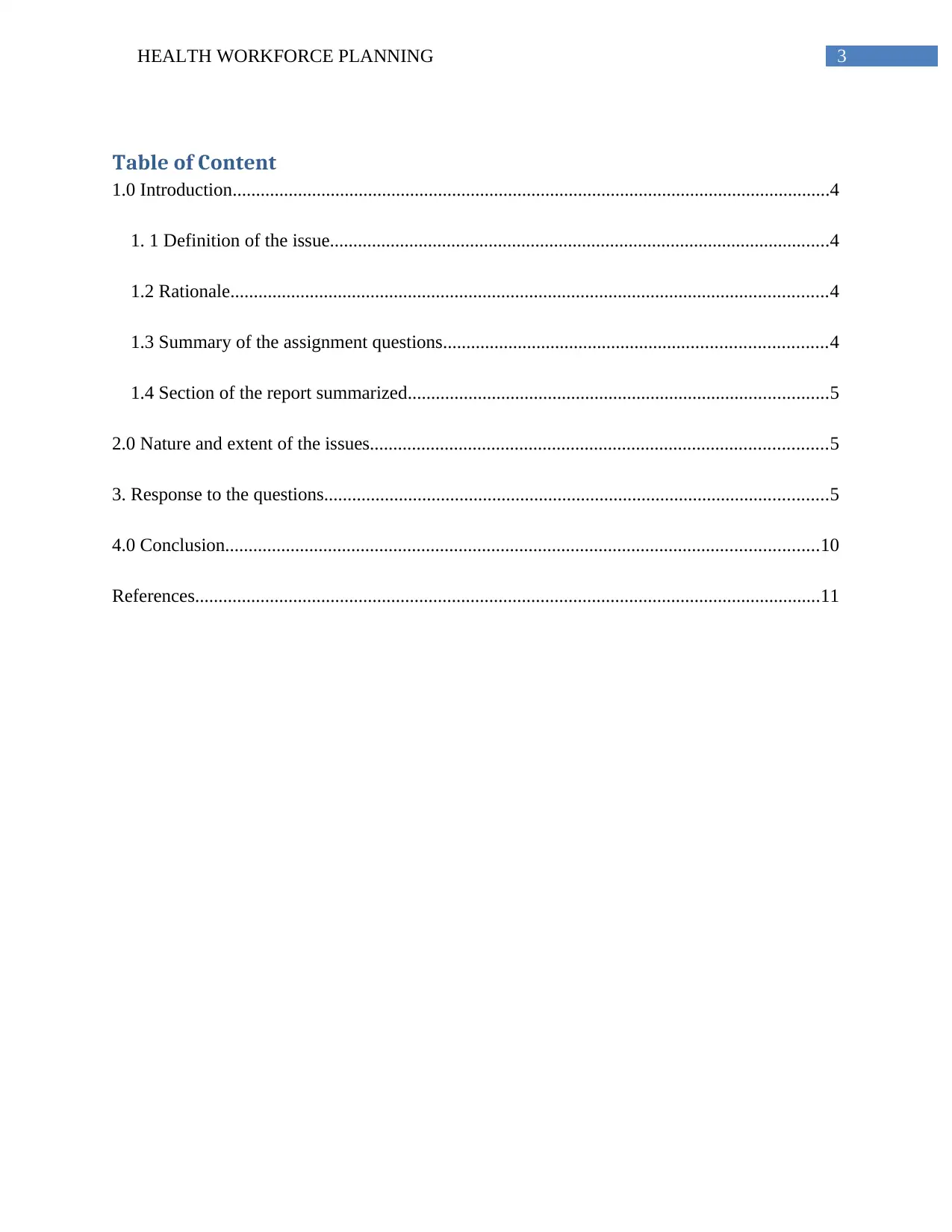
3HEALTH WORKFORCE PLANNING
Table of Content
1.0 Introduction................................................................................................................................4
1. 1 Definition of the issue...........................................................................................................4
1.2 Rationale................................................................................................................................4
1.3 Summary of the assignment questions..................................................................................4
1.4 Section of the report summarized..........................................................................................5
2.0 Nature and extent of the issues..................................................................................................5
3. Response to the questions............................................................................................................5
4.0 Conclusion...............................................................................................................................10
References......................................................................................................................................11
Table of Content
1.0 Introduction................................................................................................................................4
1. 1 Definition of the issue...........................................................................................................4
1.2 Rationale................................................................................................................................4
1.3 Summary of the assignment questions..................................................................................4
1.4 Section of the report summarized..........................................................................................5
2.0 Nature and extent of the issues..................................................................................................5
3. Response to the questions............................................................................................................5
4.0 Conclusion...............................................................................................................................10
References......................................................................................................................................11
⊘ This is a preview!⊘
Do you want full access?
Subscribe today to unlock all pages.

Trusted by 1+ million students worldwide
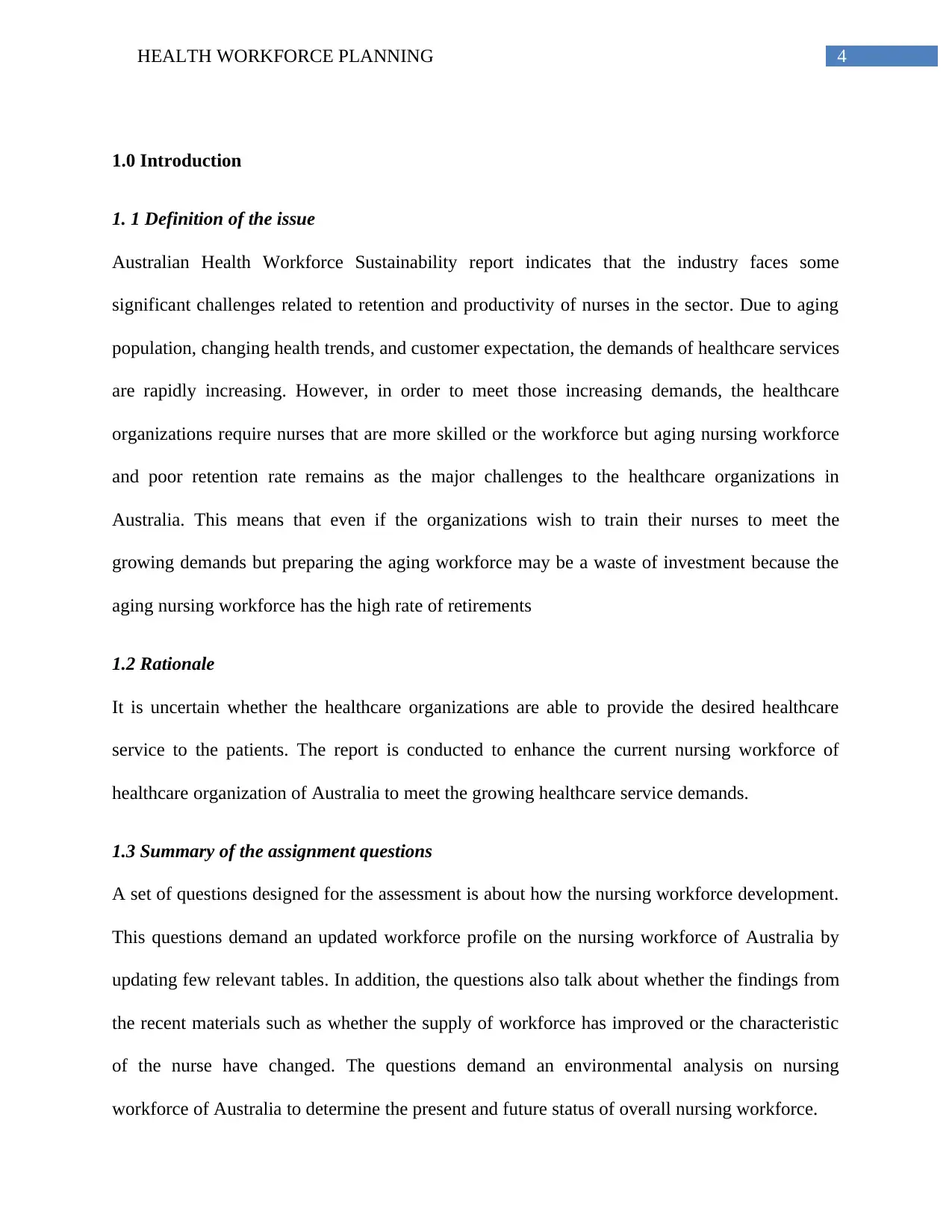
4HEALTH WORKFORCE PLANNING
1.0 Introduction
1. 1 Definition of the issue
Australian Health Workforce Sustainability report indicates that the industry faces some
significant challenges related to retention and productivity of nurses in the sector. Due to aging
population, changing health trends, and customer expectation, the demands of healthcare services
are rapidly increasing. However, in order to meet those increasing demands, the healthcare
organizations require nurses that are more skilled or the workforce but aging nursing workforce
and poor retention rate remains as the major challenges to the healthcare organizations in
Australia. This means that even if the organizations wish to train their nurses to meet the
growing demands but preparing the aging workforce may be a waste of investment because the
aging nursing workforce has the high rate of retirements
1.2 Rationale
It is uncertain whether the healthcare organizations are able to provide the desired healthcare
service to the patients. The report is conducted to enhance the current nursing workforce of
healthcare organization of Australia to meet the growing healthcare service demands.
1.3 Summary of the assignment questions
A set of questions designed for the assessment is about how the nursing workforce development.
This questions demand an updated workforce profile on the nursing workforce of Australia by
updating few relevant tables. In addition, the questions also talk about whether the findings from
the recent materials such as whether the supply of workforce has improved or the characteristic
of the nurse have changed. The questions demand an environmental analysis on nursing
workforce of Australia to determine the present and future status of overall nursing workforce.
1.0 Introduction
1. 1 Definition of the issue
Australian Health Workforce Sustainability report indicates that the industry faces some
significant challenges related to retention and productivity of nurses in the sector. Due to aging
population, changing health trends, and customer expectation, the demands of healthcare services
are rapidly increasing. However, in order to meet those increasing demands, the healthcare
organizations require nurses that are more skilled or the workforce but aging nursing workforce
and poor retention rate remains as the major challenges to the healthcare organizations in
Australia. This means that even if the organizations wish to train their nurses to meet the
growing demands but preparing the aging workforce may be a waste of investment because the
aging nursing workforce has the high rate of retirements
1.2 Rationale
It is uncertain whether the healthcare organizations are able to provide the desired healthcare
service to the patients. The report is conducted to enhance the current nursing workforce of
healthcare organization of Australia to meet the growing healthcare service demands.
1.3 Summary of the assignment questions
A set of questions designed for the assessment is about how the nursing workforce development.
This questions demand an updated workforce profile on the nursing workforce of Australia by
updating few relevant tables. In addition, the questions also talk about whether the findings from
the recent materials such as whether the supply of workforce has improved or the characteristic
of the nurse have changed. The questions demand an environmental analysis on nursing
workforce of Australia to determine the present and future status of overall nursing workforce.
Paraphrase This Document
Need a fresh take? Get an instant paraphrase of this document with our AI Paraphraser
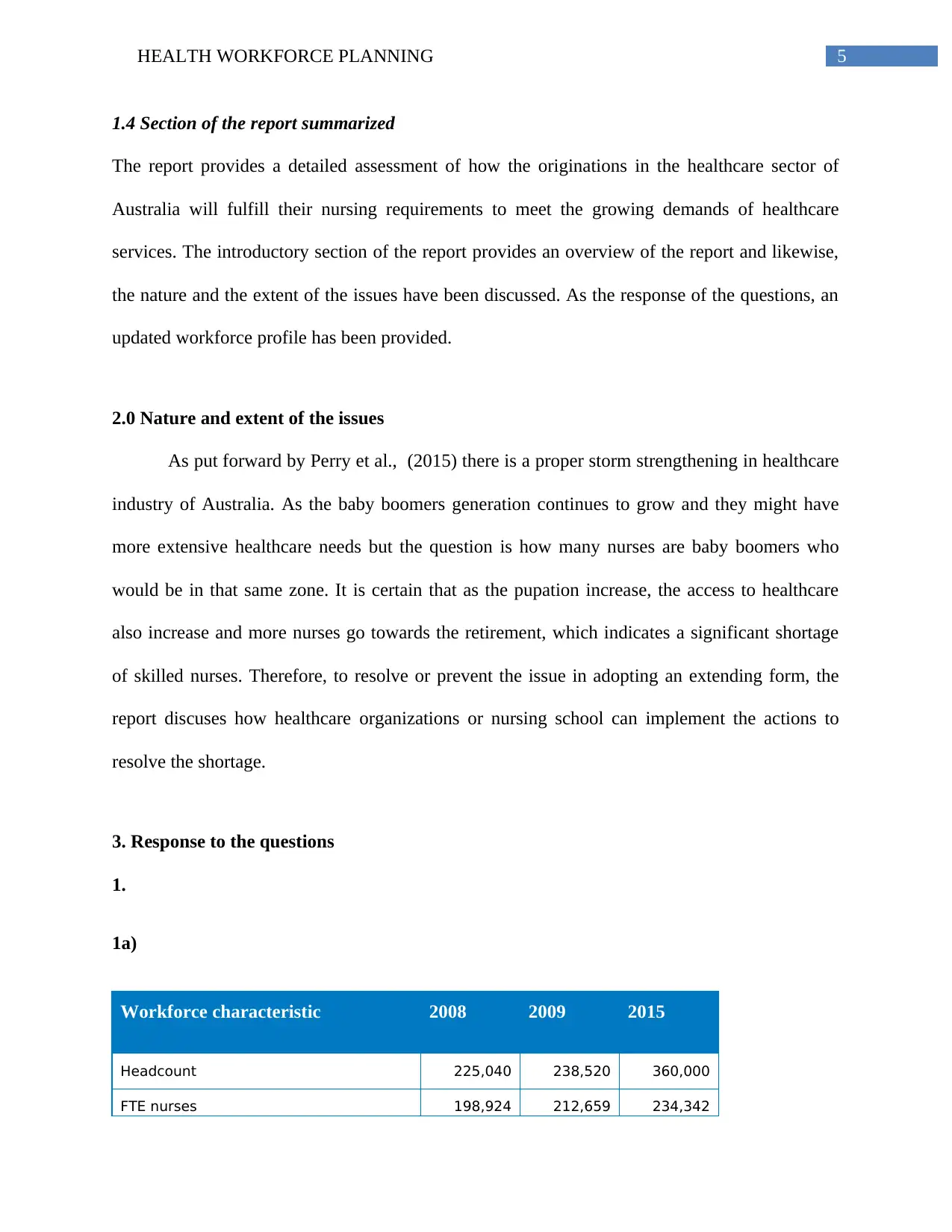
5HEALTH WORKFORCE PLANNING
1.4 Section of the report summarized
The report provides a detailed assessment of how the originations in the healthcare sector of
Australia will fulfill their nursing requirements to meet the growing demands of healthcare
services. The introductory section of the report provides an overview of the report and likewise,
the nature and the extent of the issues have been discussed. As the response of the questions, an
updated workforce profile has been provided.
2.0 Nature and extent of the issues
As put forward by Perry et al., (2015) there is a proper storm strengthening in healthcare
industry of Australia. As the baby boomers generation continues to grow and they might have
more extensive healthcare needs but the question is how many nurses are baby boomers who
would be in that same zone. It is certain that as the pupation increase, the access to healthcare
also increase and more nurses go towards the retirement, which indicates a significant shortage
of skilled nurses. Therefore, to resolve or prevent the issue in adopting an extending form, the
report discuses how healthcare organizations or nursing school can implement the actions to
resolve the shortage.
3. Response to the questions
1.
1a)
Workforce characteristic 2008 2009 2015
Headcount 225,040 238,520 360,000
FTE nurses 198,924 212,659 234,342
1.4 Section of the report summarized
The report provides a detailed assessment of how the originations in the healthcare sector of
Australia will fulfill their nursing requirements to meet the growing demands of healthcare
services. The introductory section of the report provides an overview of the report and likewise,
the nature and the extent of the issues have been discussed. As the response of the questions, an
updated workforce profile has been provided.
2.0 Nature and extent of the issues
As put forward by Perry et al., (2015) there is a proper storm strengthening in healthcare
industry of Australia. As the baby boomers generation continues to grow and they might have
more extensive healthcare needs but the question is how many nurses are baby boomers who
would be in that same zone. It is certain that as the pupation increase, the access to healthcare
also increase and more nurses go towards the retirement, which indicates a significant shortage
of skilled nurses. Therefore, to resolve or prevent the issue in adopting an extending form, the
report discuses how healthcare organizations or nursing school can implement the actions to
resolve the shortage.
3. Response to the questions
1.
1a)
Workforce characteristic 2008 2009 2015
Headcount 225,040 238,520 360,000
FTE nurses 198,924 212,659 234,342
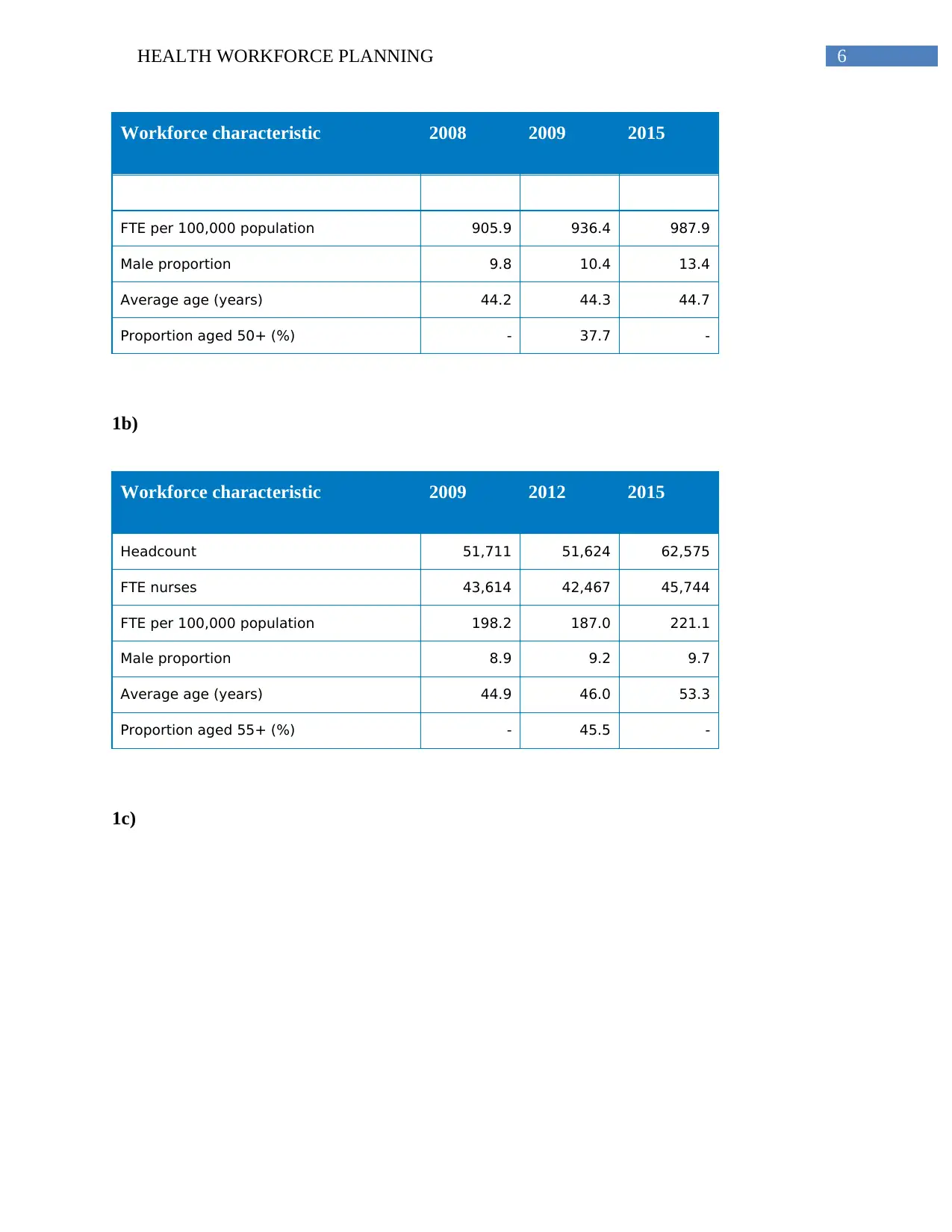
6HEALTH WORKFORCE PLANNING
Workforce characteristic 2008 2009 2015
FTE per 100,000 population 905.9 936.4 987.9
Male proportion 9.8 10.4 13.4
Average age (years) 44.2 44.3 44.7
Proportion aged 50+ (%) - 37.7 -
1b)
Workforce characteristic 2009 2012 2015
Headcount 51,711 51,624 62,575
FTE nurses 43,614 42,467 45,744
FTE per 100,000 population 198.2 187.0 221.1
Male proportion 8.9 9.2 9.7
Average age (years) 44.9 46.0 53.3
Proportion aged 55+ (%) - 45.5 -
1c)
Workforce characteristic 2008 2009 2015
FTE per 100,000 population 905.9 936.4 987.9
Male proportion 9.8 10.4 13.4
Average age (years) 44.2 44.3 44.7
Proportion aged 50+ (%) - 37.7 -
1b)
Workforce characteristic 2009 2012 2015
Headcount 51,711 51,624 62,575
FTE nurses 43,614 42,467 45,744
FTE per 100,000 population 198.2 187.0 221.1
Male proportion 8.9 9.2 9.7
Average age (years) 44.9 46.0 53.3
Proportion aged 55+ (%) - 45.5 -
1c)
⊘ This is a preview!⊘
Do you want full access?
Subscribe today to unlock all pages.

Trusted by 1+ million students worldwide
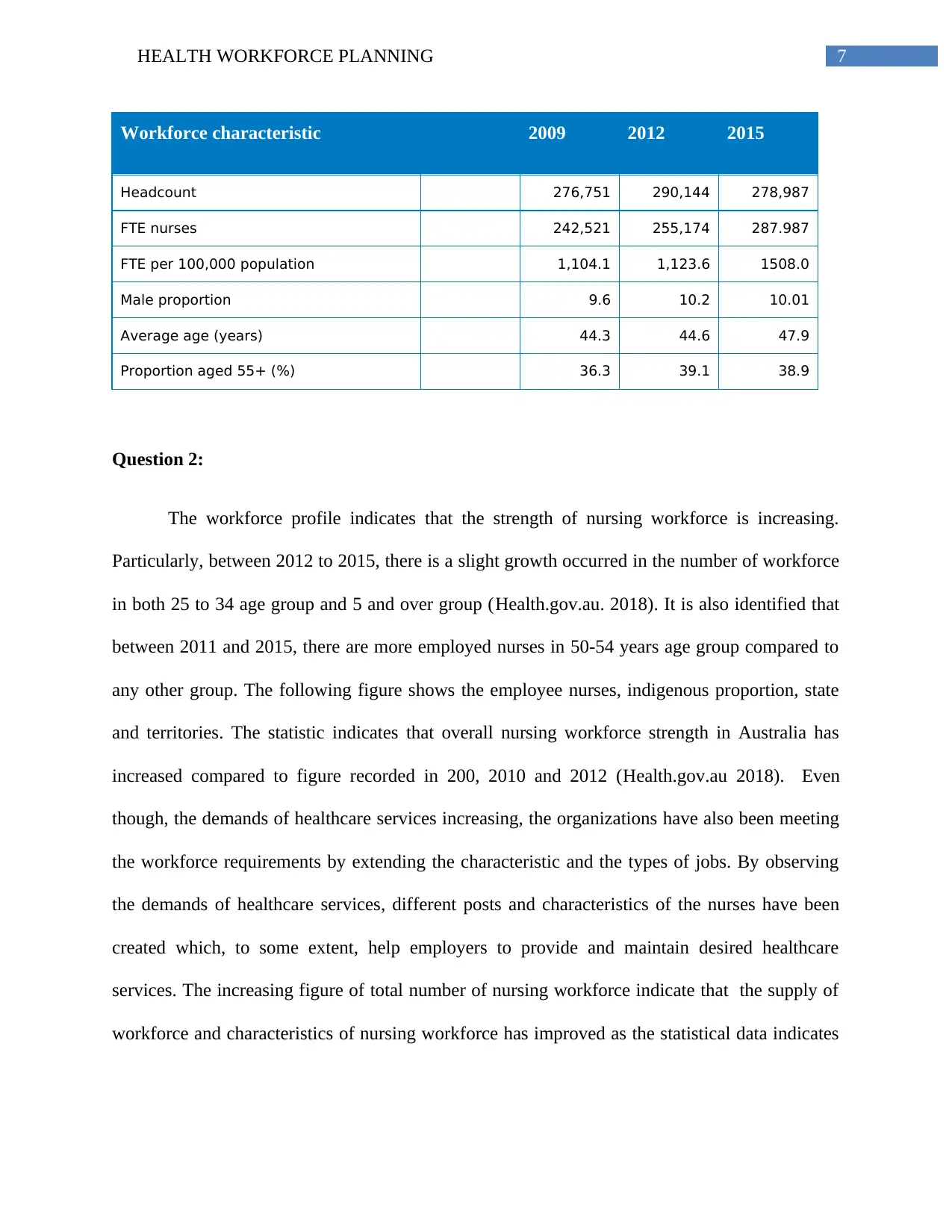
7HEALTH WORKFORCE PLANNING
Workforce characteristic 2009 2012 2015
Headcount 276,751 290,144 278,987
FTE nurses 242,521 255,174 287.987
FTE per 100,000 population 1,104.1 1,123.6 1508.0
Male proportion 9.6 10.2 10.01
Average age (years) 44.3 44.6 47.9
Proportion aged 55+ (%) 36.3 39.1 38.9
Question 2:
The workforce profile indicates that the strength of nursing workforce is increasing.
Particularly, between 2012 to 2015, there is a slight growth occurred in the number of workforce
in both 25 to 34 age group and 5 and over group (Health.gov.au. 2018). It is also identified that
between 2011 and 2015, there are more employed nurses in 50-54 years age group compared to
any other group. The following figure shows the employee nurses, indigenous proportion, state
and territories. The statistic indicates that overall nursing workforce strength in Australia has
increased compared to figure recorded in 200, 2010 and 2012 (Health.gov.au 2018). Even
though, the demands of healthcare services increasing, the organizations have also been meeting
the workforce requirements by extending the characteristic and the types of jobs. By observing
the demands of healthcare services, different posts and characteristics of the nurses have been
created which, to some extent, help employers to provide and maintain desired healthcare
services. The increasing figure of total number of nursing workforce indicate that the supply of
workforce and characteristics of nursing workforce has improved as the statistical data indicates
Workforce characteristic 2009 2012 2015
Headcount 276,751 290,144 278,987
FTE nurses 242,521 255,174 287.987
FTE per 100,000 population 1,104.1 1,123.6 1508.0
Male proportion 9.6 10.2 10.01
Average age (years) 44.3 44.6 47.9
Proportion aged 55+ (%) 36.3 39.1 38.9
Question 2:
The workforce profile indicates that the strength of nursing workforce is increasing.
Particularly, between 2012 to 2015, there is a slight growth occurred in the number of workforce
in both 25 to 34 age group and 5 and over group (Health.gov.au. 2018). It is also identified that
between 2011 and 2015, there are more employed nurses in 50-54 years age group compared to
any other group. The following figure shows the employee nurses, indigenous proportion, state
and territories. The statistic indicates that overall nursing workforce strength in Australia has
increased compared to figure recorded in 200, 2010 and 2012 (Health.gov.au 2018). Even
though, the demands of healthcare services increasing, the organizations have also been meeting
the workforce requirements by extending the characteristic and the types of jobs. By observing
the demands of healthcare services, different posts and characteristics of the nurses have been
created which, to some extent, help employers to provide and maintain desired healthcare
services. The increasing figure of total number of nursing workforce indicate that the supply of
workforce and characteristics of nursing workforce has improved as the statistical data indicates
Paraphrase This Document
Need a fresh take? Get an instant paraphrase of this document with our AI Paraphraser
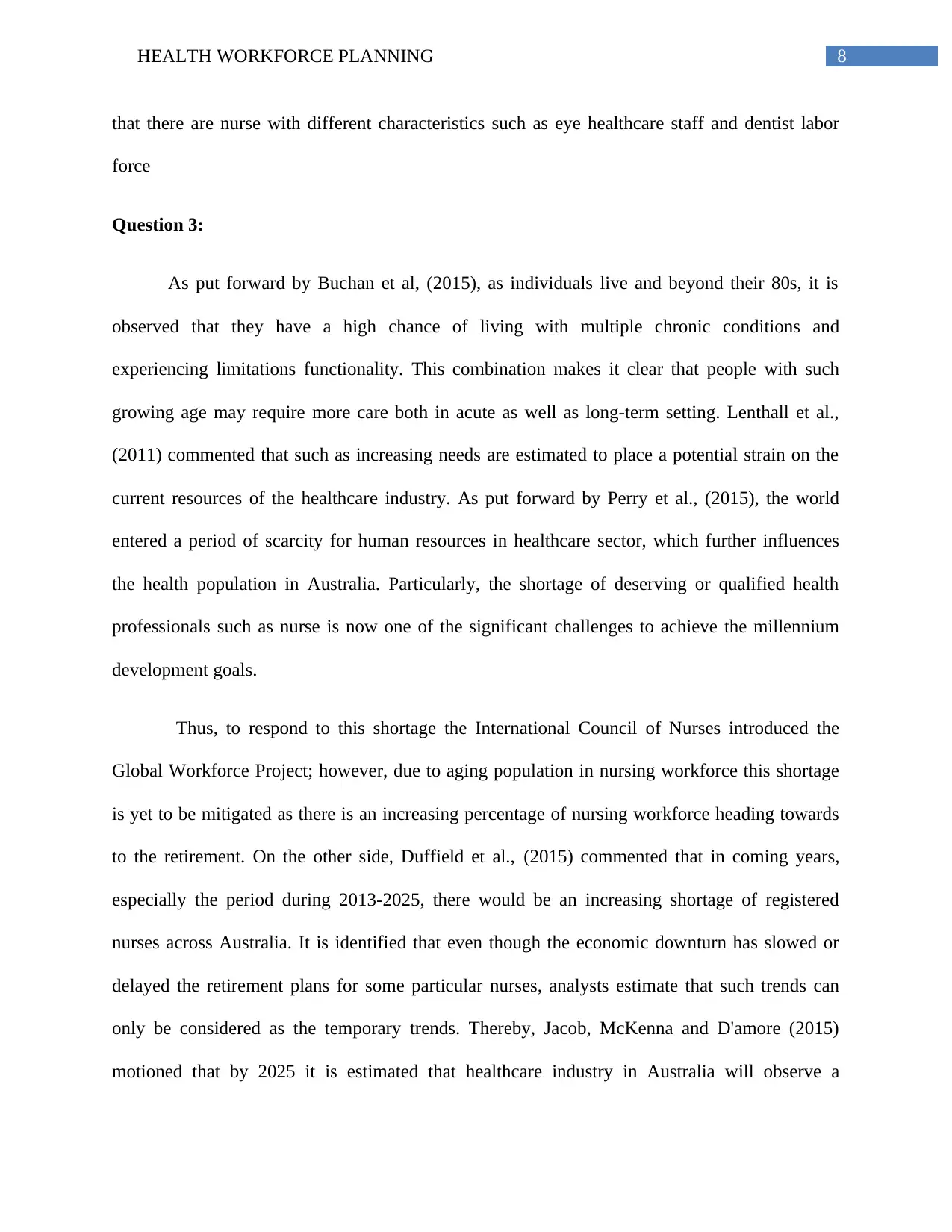
8HEALTH WORKFORCE PLANNING
that there are nurse with different characteristics such as eye healthcare staff and dentist labor
force
Question 3:
As put forward by Buchan et al, (2015), as individuals live and beyond their 80s, it is
observed that they have a high chance of living with multiple chronic conditions and
experiencing limitations functionality. This combination makes it clear that people with such
growing age may require more care both in acute as well as long-term setting. Lenthall et al.,
(2011) commented that such as increasing needs are estimated to place a potential strain on the
current resources of the healthcare industry. As put forward by Perry et al., (2015), the world
entered a period of scarcity for human resources in healthcare sector, which further influences
the health population in Australia. Particularly, the shortage of deserving or qualified health
professionals such as nurse is now one of the significant challenges to achieve the millennium
development goals.
Thus, to respond to this shortage the International Council of Nurses introduced the
Global Workforce Project; however, due to aging population in nursing workforce this shortage
is yet to be mitigated as there is an increasing percentage of nursing workforce heading towards
to the retirement. On the other side, Duffield et al., (2015) commented that in coming years,
especially the period during 2013-2025, there would be an increasing shortage of registered
nurses across Australia. It is identified that even though the economic downturn has slowed or
delayed the retirement plans for some particular nurses, analysts estimate that such trends can
only be considered as the temporary trends. Thereby, Jacob, McKenna and D'amore (2015)
motioned that by 2025 it is estimated that healthcare industry in Australia will observe a
that there are nurse with different characteristics such as eye healthcare staff and dentist labor
force
Question 3:
As put forward by Buchan et al, (2015), as individuals live and beyond their 80s, it is
observed that they have a high chance of living with multiple chronic conditions and
experiencing limitations functionality. This combination makes it clear that people with such
growing age may require more care both in acute as well as long-term setting. Lenthall et al.,
(2011) commented that such as increasing needs are estimated to place a potential strain on the
current resources of the healthcare industry. As put forward by Perry et al., (2015), the world
entered a period of scarcity for human resources in healthcare sector, which further influences
the health population in Australia. Particularly, the shortage of deserving or qualified health
professionals such as nurse is now one of the significant challenges to achieve the millennium
development goals.
Thus, to respond to this shortage the International Council of Nurses introduced the
Global Workforce Project; however, due to aging population in nursing workforce this shortage
is yet to be mitigated as there is an increasing percentage of nursing workforce heading towards
to the retirement. On the other side, Duffield et al., (2015) commented that in coming years,
especially the period during 2013-2025, there would be an increasing shortage of registered
nurses across Australia. It is identified that even though the economic downturn has slowed or
delayed the retirement plans for some particular nurses, analysts estimate that such trends can
only be considered as the temporary trends. Thereby, Jacob, McKenna and D'amore (2015)
motioned that by 2025 it is estimated that healthcare industry in Australia will observe a
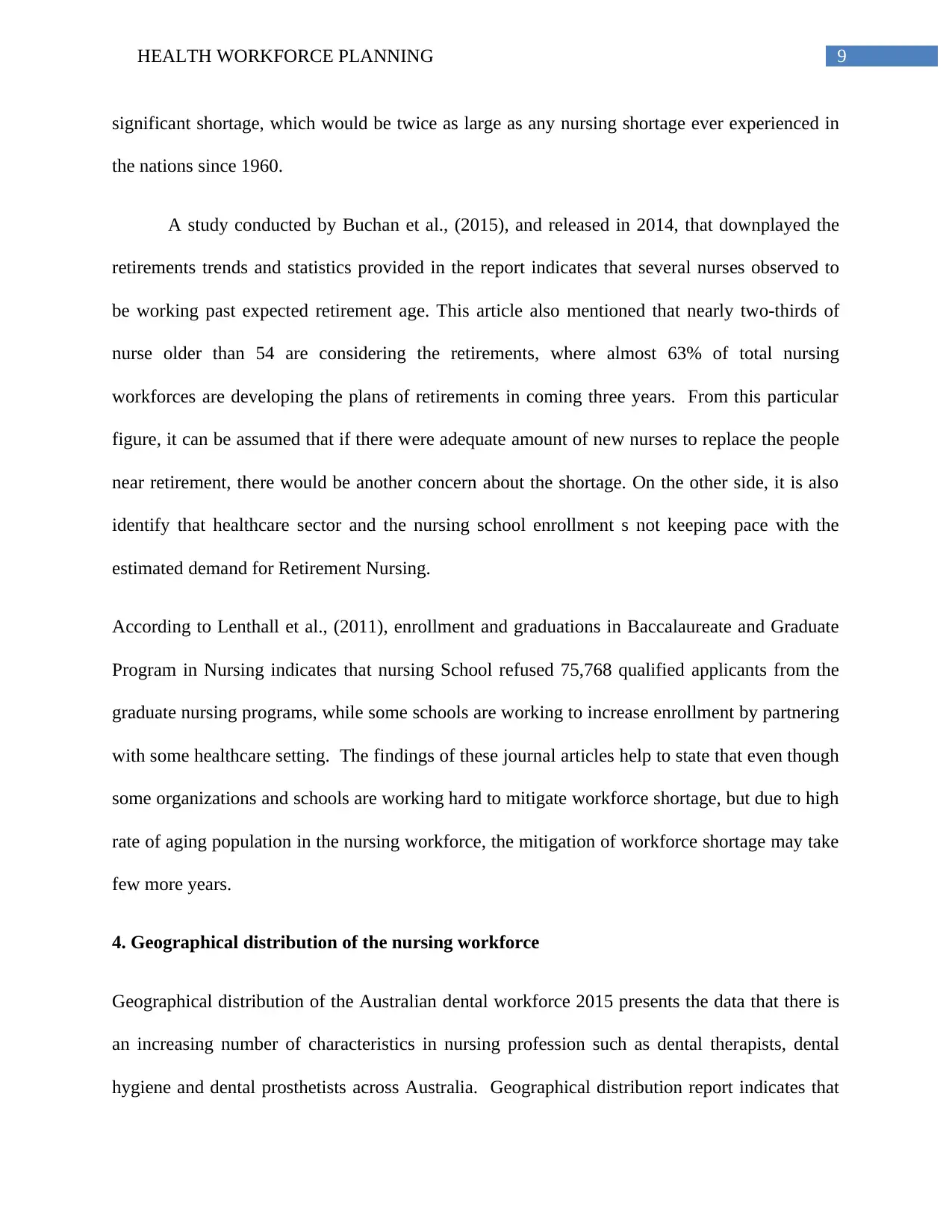
9HEALTH WORKFORCE PLANNING
significant shortage, which would be twice as large as any nursing shortage ever experienced in
the nations since 1960.
A study conducted by Buchan et al., (2015), and released in 2014, that downplayed the
retirements trends and statistics provided in the report indicates that several nurses observed to
be working past expected retirement age. This article also mentioned that nearly two-thirds of
nurse older than 54 are considering the retirements, where almost 63% of total nursing
workforces are developing the plans of retirements in coming three years. From this particular
figure, it can be assumed that if there were adequate amount of new nurses to replace the people
near retirement, there would be another concern about the shortage. On the other side, it is also
identify that healthcare sector and the nursing school enrollment s not keeping pace with the
estimated demand for Retirement Nursing.
According to Lenthall et al., (2011), enrollment and graduations in Baccalaureate and Graduate
Program in Nursing indicates that nursing School refused 75,768 qualified applicants from the
graduate nursing programs, while some schools are working to increase enrollment by partnering
with some healthcare setting. The findings of these journal articles help to state that even though
some organizations and schools are working hard to mitigate workforce shortage, but due to high
rate of aging population in the nursing workforce, the mitigation of workforce shortage may take
few more years.
4. Geographical distribution of the nursing workforce
Geographical distribution of the Australian dental workforce 2015 presents the data that there is
an increasing number of characteristics in nursing profession such as dental therapists, dental
hygiene and dental prosthetists across Australia. Geographical distribution report indicates that
significant shortage, which would be twice as large as any nursing shortage ever experienced in
the nations since 1960.
A study conducted by Buchan et al., (2015), and released in 2014, that downplayed the
retirements trends and statistics provided in the report indicates that several nurses observed to
be working past expected retirement age. This article also mentioned that nearly two-thirds of
nurse older than 54 are considering the retirements, where almost 63% of total nursing
workforces are developing the plans of retirements in coming three years. From this particular
figure, it can be assumed that if there were adequate amount of new nurses to replace the people
near retirement, there would be another concern about the shortage. On the other side, it is also
identify that healthcare sector and the nursing school enrollment s not keeping pace with the
estimated demand for Retirement Nursing.
According to Lenthall et al., (2011), enrollment and graduations in Baccalaureate and Graduate
Program in Nursing indicates that nursing School refused 75,768 qualified applicants from the
graduate nursing programs, while some schools are working to increase enrollment by partnering
with some healthcare setting. The findings of these journal articles help to state that even though
some organizations and schools are working hard to mitigate workforce shortage, but due to high
rate of aging population in the nursing workforce, the mitigation of workforce shortage may take
few more years.
4. Geographical distribution of the nursing workforce
Geographical distribution of the Australian dental workforce 2015 presents the data that there is
an increasing number of characteristics in nursing profession such as dental therapists, dental
hygiene and dental prosthetists across Australia. Geographical distribution report indicates that
⊘ This is a preview!⊘
Do you want full access?
Subscribe today to unlock all pages.

Trusted by 1+ million students worldwide
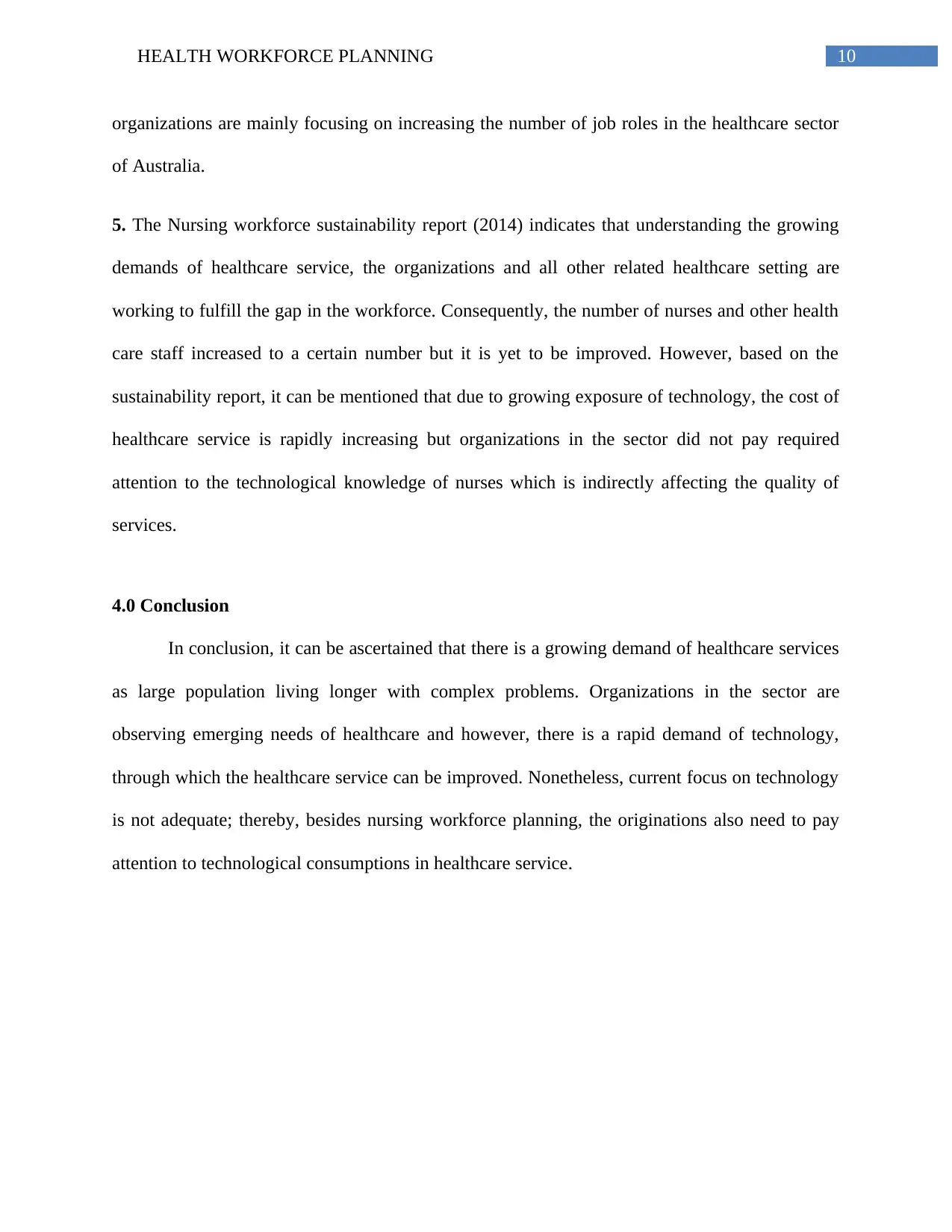
10HEALTH WORKFORCE PLANNING
organizations are mainly focusing on increasing the number of job roles in the healthcare sector
of Australia.
5. The Nursing workforce sustainability report (2014) indicates that understanding the growing
demands of healthcare service, the organizations and all other related healthcare setting are
working to fulfill the gap in the workforce. Consequently, the number of nurses and other health
care staff increased to a certain number but it is yet to be improved. However, based on the
sustainability report, it can be mentioned that due to growing exposure of technology, the cost of
healthcare service is rapidly increasing but organizations in the sector did not pay required
attention to the technological knowledge of nurses which is indirectly affecting the quality of
services.
4.0 Conclusion
In conclusion, it can be ascertained that there is a growing demand of healthcare services
as large population living longer with complex problems. Organizations in the sector are
observing emerging needs of healthcare and however, there is a rapid demand of technology,
through which the healthcare service can be improved. Nonetheless, current focus on technology
is not adequate; thereby, besides nursing workforce planning, the originations also need to pay
attention to technological consumptions in healthcare service.
organizations are mainly focusing on increasing the number of job roles in the healthcare sector
of Australia.
5. The Nursing workforce sustainability report (2014) indicates that understanding the growing
demands of healthcare service, the organizations and all other related healthcare setting are
working to fulfill the gap in the workforce. Consequently, the number of nurses and other health
care staff increased to a certain number but it is yet to be improved. However, based on the
sustainability report, it can be mentioned that due to growing exposure of technology, the cost of
healthcare service is rapidly increasing but organizations in the sector did not pay required
attention to the technological knowledge of nurses which is indirectly affecting the quality of
services.
4.0 Conclusion
In conclusion, it can be ascertained that there is a growing demand of healthcare services
as large population living longer with complex problems. Organizations in the sector are
observing emerging needs of healthcare and however, there is a rapid demand of technology,
through which the healthcare service can be improved. Nonetheless, current focus on technology
is not adequate; thereby, besides nursing workforce planning, the originations also need to pay
attention to technological consumptions in healthcare service.
Paraphrase This Document
Need a fresh take? Get an instant paraphrase of this document with our AI Paraphraser
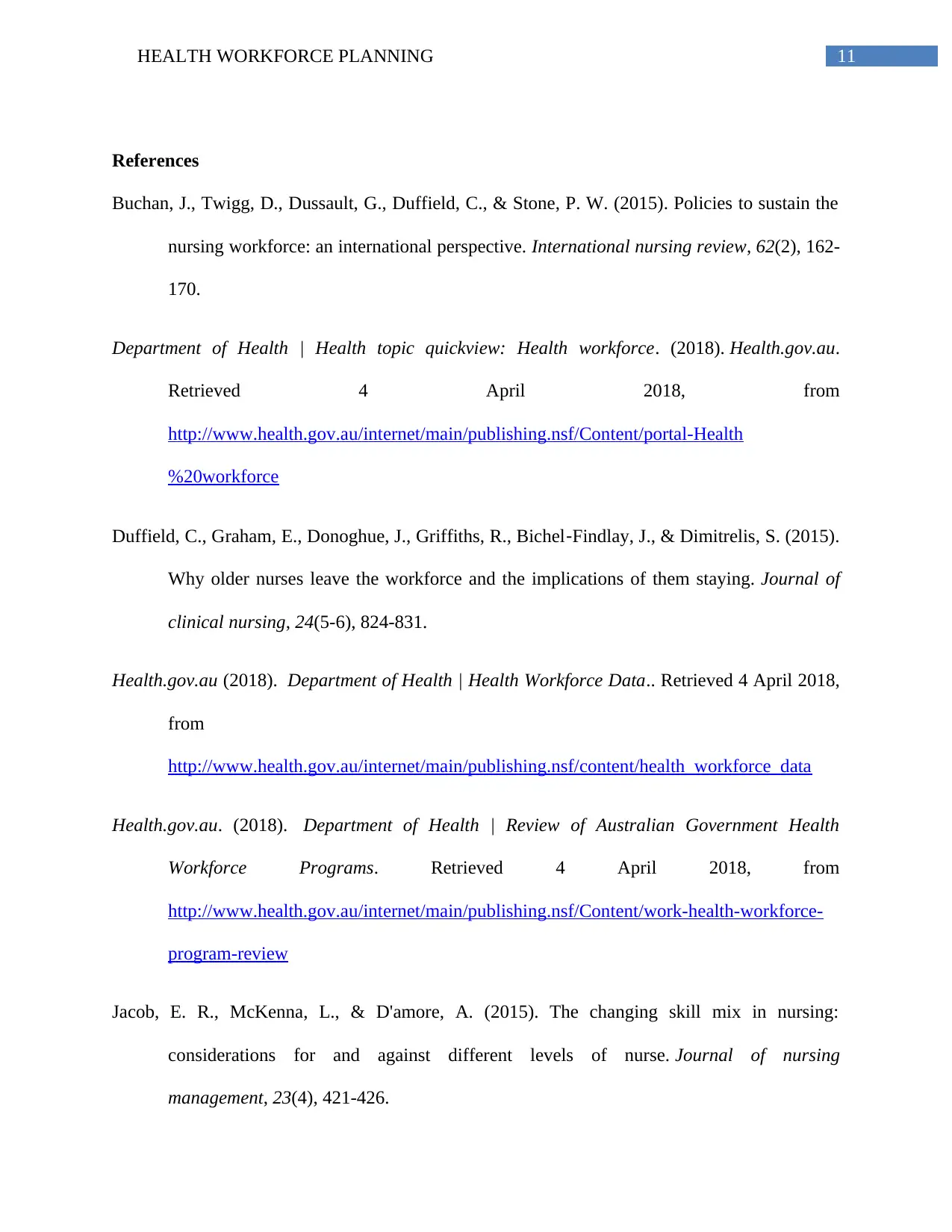
11HEALTH WORKFORCE PLANNING
References
Buchan, J., Twigg, D., Dussault, G., Duffield, C., & Stone, P. W. (2015). Policies to sustain the
nursing workforce: an international perspective. International nursing review, 62(2), 162-
170.
Department of Health | Health topic quickview: Health workforce. (2018). Health.gov.au.
Retrieved 4 April 2018, from
http://www.health.gov.au/internet/main/publishing.nsf/Content/portal-Health
%20workforce
Duffield, C., Graham, E., Donoghue, J., Griffiths, R., Bichel‐Findlay, J., & Dimitrelis, S. (2015).
Why older nurses leave the workforce and the implications of them staying. Journal of
clinical nursing, 24(5-6), 824-831.
Health.gov.au (2018). Department of Health | Health Workforce Data.. Retrieved 4 April 2018,
from
http://www.health.gov.au/internet/main/publishing.nsf/content/health_workforce_data
Health.gov.au. (2018). Department of Health | Review of Australian Government Health
Workforce Programs. Retrieved 4 April 2018, from
http://www.health.gov.au/internet/main/publishing.nsf/Content/work-health-workforce-
program-review
Jacob, E. R., McKenna, L., & D'amore, A. (2015). The changing skill mix in nursing:
considerations for and against different levels of nurse. Journal of nursing
management, 23(4), 421-426.
References
Buchan, J., Twigg, D., Dussault, G., Duffield, C., & Stone, P. W. (2015). Policies to sustain the
nursing workforce: an international perspective. International nursing review, 62(2), 162-
170.
Department of Health | Health topic quickview: Health workforce. (2018). Health.gov.au.
Retrieved 4 April 2018, from
http://www.health.gov.au/internet/main/publishing.nsf/Content/portal-Health
%20workforce
Duffield, C., Graham, E., Donoghue, J., Griffiths, R., Bichel‐Findlay, J., & Dimitrelis, S. (2015).
Why older nurses leave the workforce and the implications of them staying. Journal of
clinical nursing, 24(5-6), 824-831.
Health.gov.au (2018). Department of Health | Health Workforce Data.. Retrieved 4 April 2018,
from
http://www.health.gov.au/internet/main/publishing.nsf/content/health_workforce_data
Health.gov.au. (2018). Department of Health | Review of Australian Government Health
Workforce Programs. Retrieved 4 April 2018, from
http://www.health.gov.au/internet/main/publishing.nsf/Content/work-health-workforce-
program-review
Jacob, E. R., McKenna, L., & D'amore, A. (2015). The changing skill mix in nursing:
considerations for and against different levels of nurse. Journal of nursing
management, 23(4), 421-426.
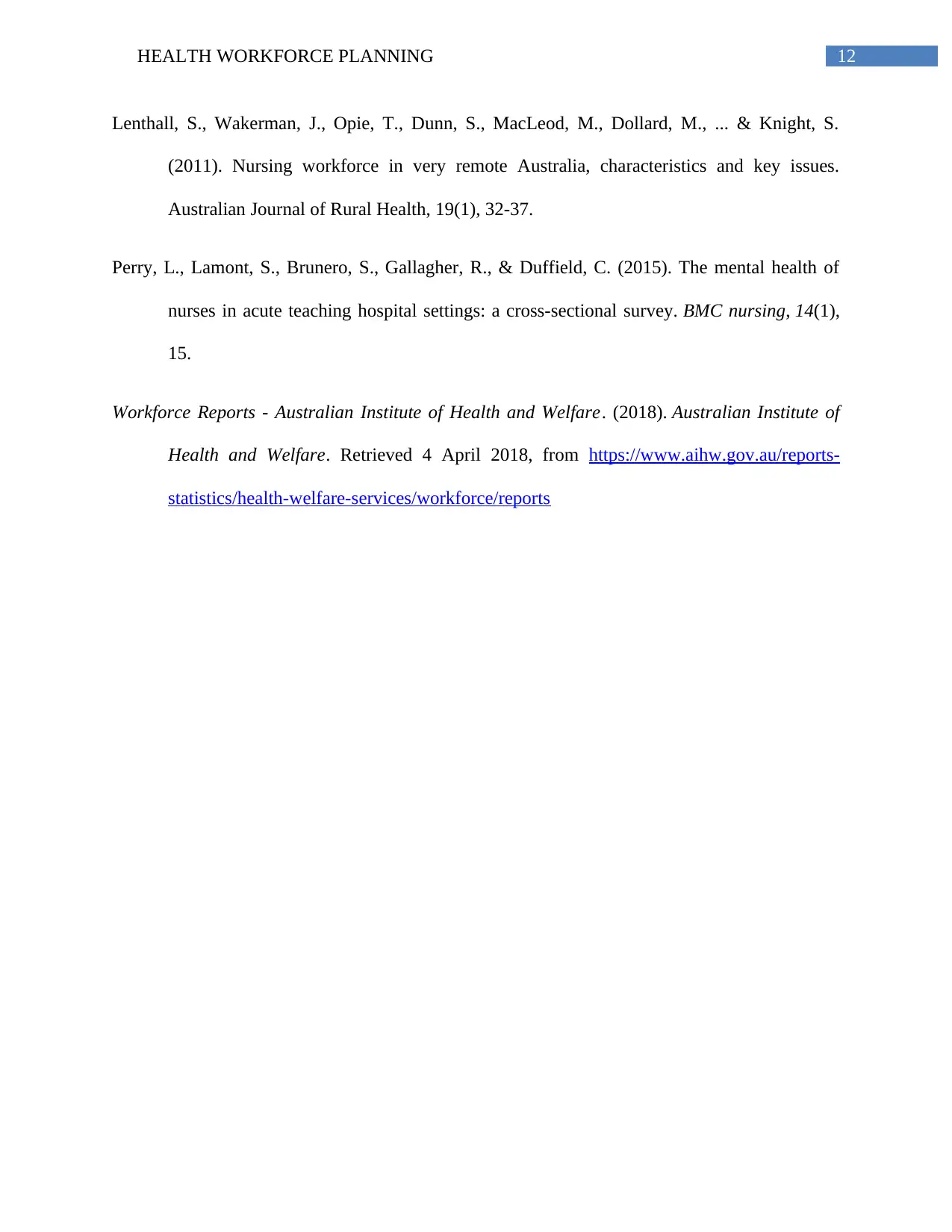
12HEALTH WORKFORCE PLANNING
Lenthall, S., Wakerman, J., Opie, T., Dunn, S., MacLeod, M., Dollard, M., ... & Knight, S.
(2011). Nursing workforce in very remote Australia, characteristics and key issues.
Australian Journal of Rural Health, 19(1), 32-37.
Perry, L., Lamont, S., Brunero, S., Gallagher, R., & Duffield, C. (2015). The mental health of
nurses in acute teaching hospital settings: a cross-sectional survey. BMC nursing, 14(1),
15.
Workforce Reports - Australian Institute of Health and Welfare. (2018). Australian Institute of
Health and Welfare. Retrieved 4 April 2018, from https://www.aihw.gov.au/reports-
statistics/health-welfare-services/workforce/reports
Lenthall, S., Wakerman, J., Opie, T., Dunn, S., MacLeod, M., Dollard, M., ... & Knight, S.
(2011). Nursing workforce in very remote Australia, characteristics and key issues.
Australian Journal of Rural Health, 19(1), 32-37.
Perry, L., Lamont, S., Brunero, S., Gallagher, R., & Duffield, C. (2015). The mental health of
nurses in acute teaching hospital settings: a cross-sectional survey. BMC nursing, 14(1),
15.
Workforce Reports - Australian Institute of Health and Welfare. (2018). Australian Institute of
Health and Welfare. Retrieved 4 April 2018, from https://www.aihw.gov.au/reports-
statistics/health-welfare-services/workforce/reports
⊘ This is a preview!⊘
Do you want full access?
Subscribe today to unlock all pages.

Trusted by 1+ million students worldwide
1 out of 12
Related Documents
Your All-in-One AI-Powered Toolkit for Academic Success.
+13062052269
info@desklib.com
Available 24*7 on WhatsApp / Email
![[object Object]](/_next/static/media/star-bottom.7253800d.svg)
Unlock your academic potential
Copyright © 2020–2025 A2Z Services. All Rights Reserved. Developed and managed by ZUCOL.




